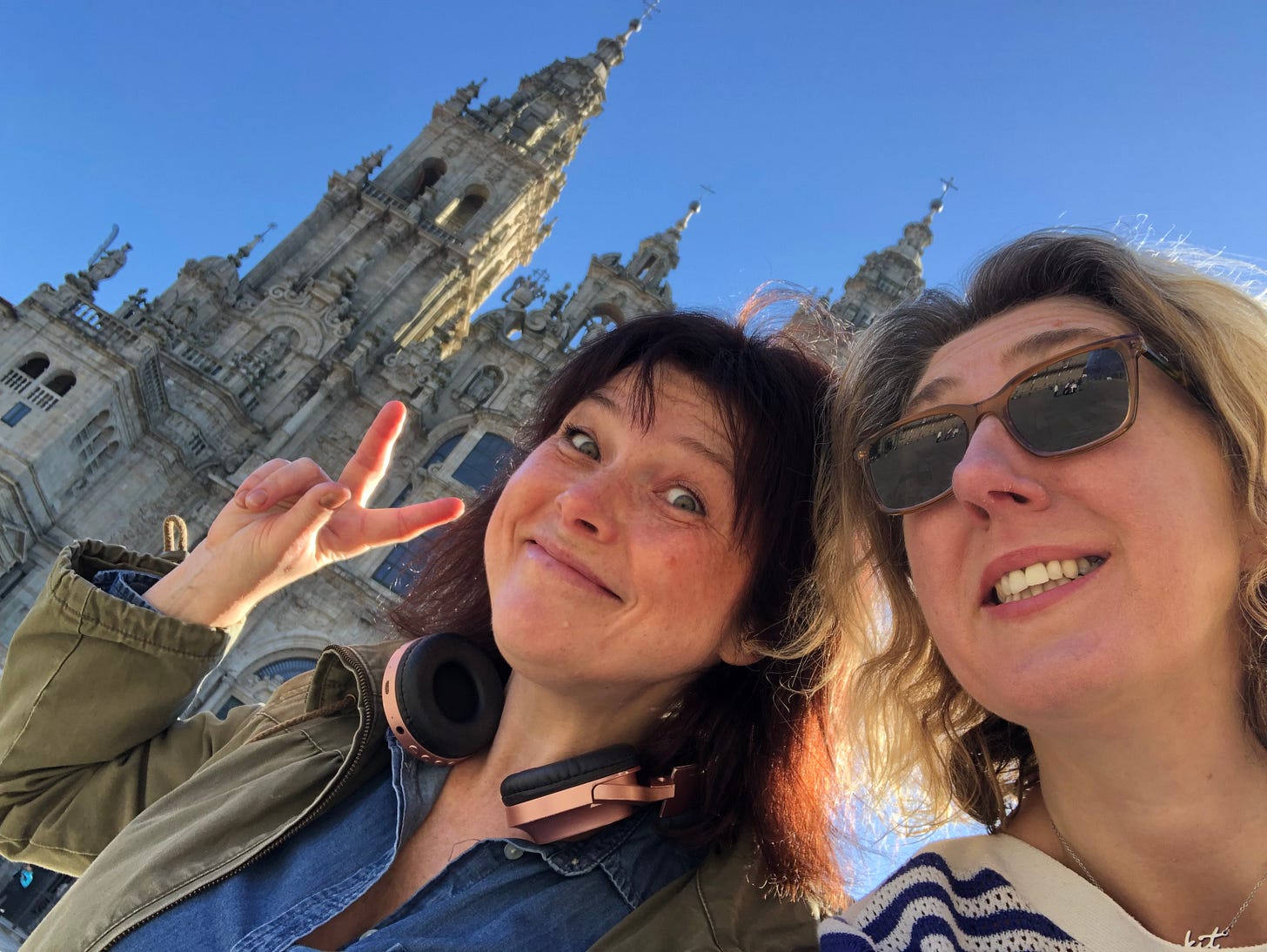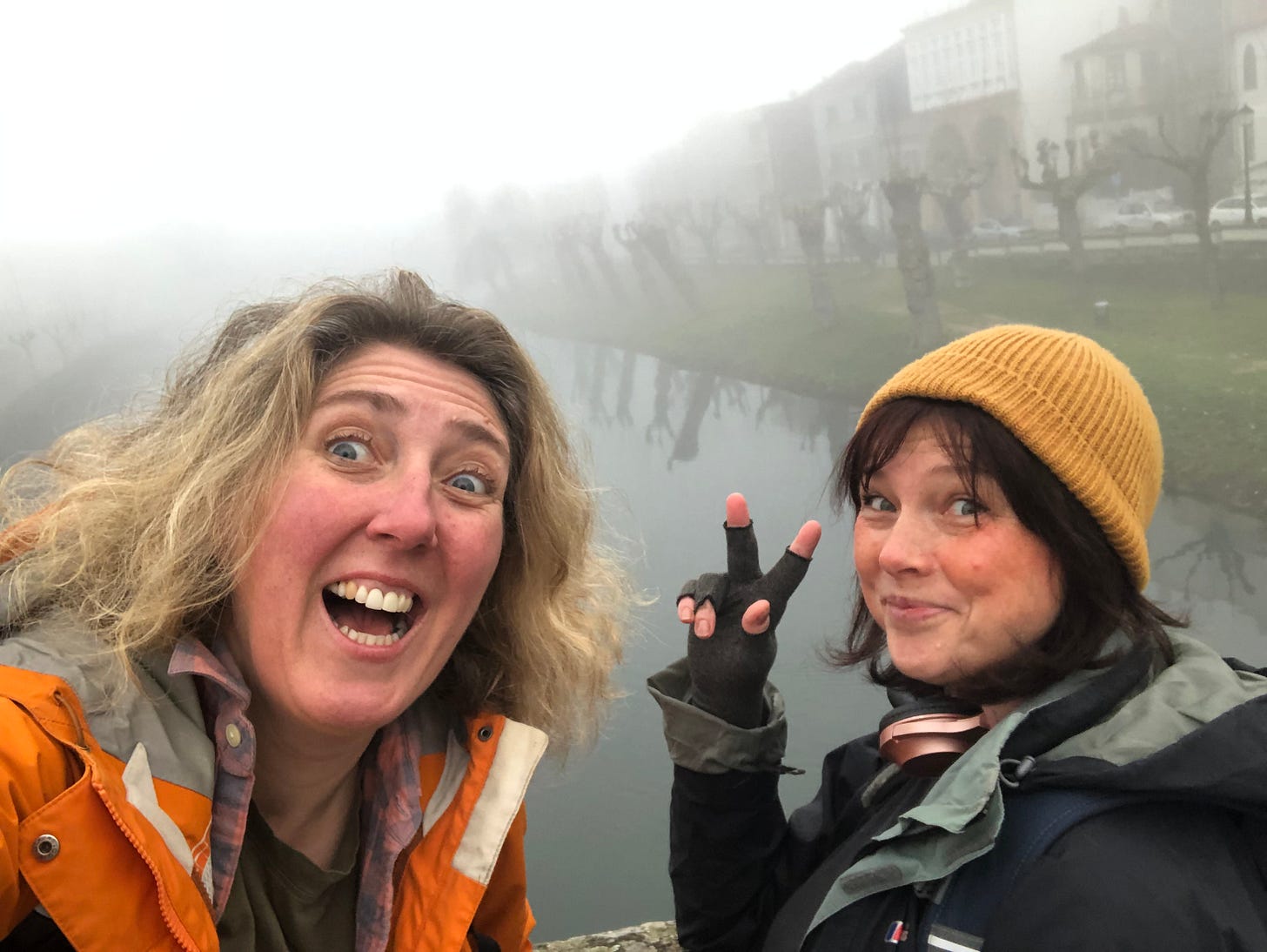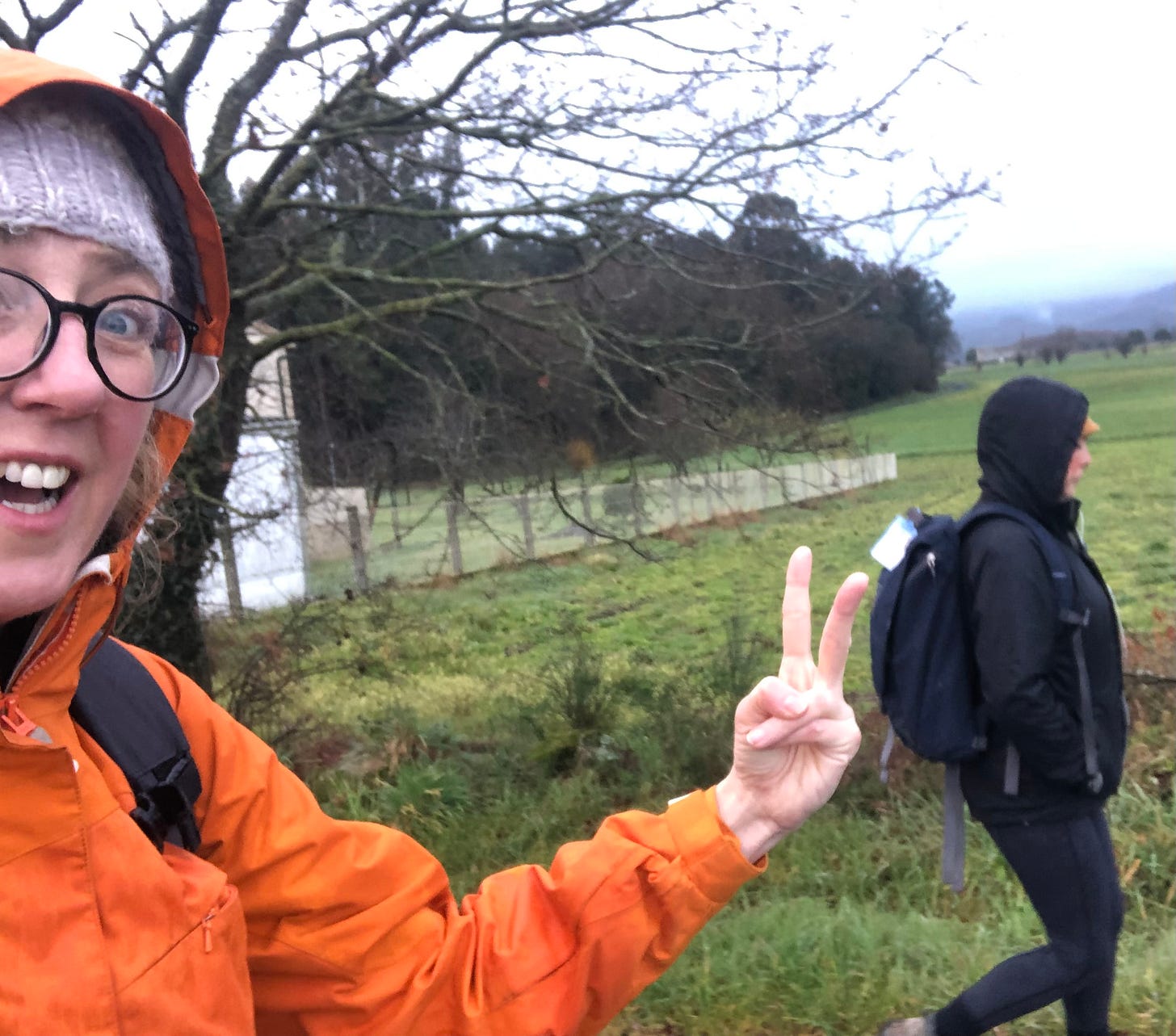When You're Fifty, Divorcing and Menopausal, All Roads Lead to Santiago
Tracey relives one of our favourite and most epic trips.
I stare down over the steep slopes lined with rows and rows of gnarled, ancient vines, the silver thread of the Sil River wiggling through the gorge, and my furious knees start to tremble. Hunched over, I check the map on my phone to see that we've still got a good ten kilometres to go before we arrive into Chantada, our stop for the night. And that's when the tears of exhaustion threaten to take over.
“Call yourself a pilgrim, Davies!” laughs Rhonda, my friend and partner-in-crime on the Camino, “Get a move on! There's beer at the end,” she hollers over her shoulder and tramps down the muddy path.
What is it about middle-aged women and challenges? If it's not a marathon or a moon walk, it's a charity trek or a bungee jump. Or in this case, a hundred kilometre walk through rural Spain. I reluctantly follow in her all-too eager footsteps, my mind now consumed by the thought of an ice-cold beer and a long hot bath, but I leave my thumb hovering tentatively over the Uber app.
Ask anyone over 50 and walking the Camino de Santiago will be pretty high on their bucket list. Originally the domain of Catholic pilgrims who would walk the 600-mile route across Europe to reduce the punishment of their sins. Now you're more likely to find adventurous women from all walks of life on the road looking for a physical challenge, to find inner peace, or, like Rhonda and I, to recalibrate after the many trials and tribulations of recent years.
And it's no surprise, really. Recent studies have shown that walking is hugely beneficial for older women. It strengthens bones, lowers menopausal symptoms and can ease the feelings of depression and low mood. In fact, Macs Adventures, the company who arranged our trip, has seen a massive spike in enquiries for Camino tours from, ahem, women of a certain age.
And while Rhonda and I are not natural long-distance walkers, since turning fifty, hitting the menopause and navigating our way through grief and divorce, we've both found ourselves a little lost in life and embarking on a challenge like the Camino seemed like a Really Good Idea over a bottle of wine. But right now, with a mud-spattered face, aching limbs and still miles to go before we sleep, I'm starting to doubt our life choices.
Travelling to find yourself is a cliché as old as time – there's good reason why books like Eat, Pray, Love and Wild have become highly worshipped bibles for middle-aged women like me. And believe me, I know. Aged 25, I went soul searching on the sandy beaches of Goa in southern India. At 40 and with three kids under my belt, I headed on a solo trip into the mountains of Vietnam in search of inner peace. And now, aged 51, I'm hoping to truly find myself on the Camino de Santiago. Translated into English as the Way of St James, the Camino de Santiago is a network of pilgrimages which lead to the cathedral of Santiago de Compostela in Galicia, northwestern Spain, where the shrine of the apostle St James the Great is laid.
A busy extrovert, I tend to live at lightning speed. I wanted the magic balm of a long-distance walk to properly slow down and work out what I want from the next chapter of my life. And I'm not the only one. Last year, more than 400,000 people walked the final stretch of the Camino into Santiago and the numbers just keep on rising. Luckily, the Camino de Invierno is quieter than the Camino Frances, the most popular route, which can feel more like a fun run than a pilgrimage in high season.
Also known as the Winter Way, it follows the natural route of the Sil River and links Galicia with the northern plains of Castilla y León. One of the lesser-trodden paths to Santiago de Compostela, the medieval pilgrims originally chose this path to avoid the snowy mountains of O Cebreiro. However, we largely chose it because it went through the Ribeira Sacra, Galicia's ancient wine region which is renowned for its steep terraces overlooking the gorge. And what soothes middle-aged, menopausal women more than walking? Wine.
Before our trek began in Monforte de Lemos, we decide to treat ourselves to a fancy lunch at a local vineyard, Adega Algueira (adegaalgueira.com) which is run by father and son team, Fernando and Fabio Gonzales. Sampling the small estate's excellent Mencia and Brancellao wines over lunch, Rhonda and I discuss our impending adventure and what we hope to get out of it.
Two years ago I instigated the end of my marriage. At the time, I was elated at the thought of being in control of my future and what it might bring. However, in hindsight, I hadn't really allowed myself proper time to process it. My three children are now older teenagers, each with their own lives. And while they sometimes need their mum – usually for money, a lift or emotional support – I often feel lost, even a little unnecessary at times.
As the great Hippocrates once said, walking is man's best medicine. And it's true. Studies have proven that long walks are not only beneficial physically, but they can help soothe and quiet a busy mind. Over the week, we walked on average 20 to 25 kilometres a day. It took me a couple of days to slow down mentally. I would listen to endless podcasts by inspirational women, audio comedy or Nineties club hits, but when my AirPods ran out of charge I had no choice but to walk alongside my thoughts. At first I would do everything to avoid them – listen to birdsong, count my steps, daydream – eventually I had no choice but to let them in.
It's early spring and the temperature is comfortable. We obediently followed the Camino's omnipresent scallop shells and yellow arrows as the route takes us along rugged country lanes, through forest paths and past farmyards, where curious (and often noisy) dogs would act as a much-needed welcoming committee. Sometimes the kilometres would tick by quickly, others it felt like time had actually stopped still. This is when we would stop and rest, maybe take a peek into one of the hundreds of Romanesque chapels which dotted the route.
Rhonda is the perfect walking companion. As we're both going through midlife mayhem, it's important to have space for ourselves on this trek. Luckily, we're close enough friends to be comfortable in silence. In fact, we only saw a handful of other pilgrims on this route, which was perfect as I knew that if I walked with others I'd want to chat, make friends, show off, do anything but be alone with my thoughts.
In the end, I think it was the monotony of walking that I enjoyed the most. Putting one foot in front of the other is a meditative balm which at times brought about some uncomfortable thoughts and emotions to the surface. But I now I had time to sit with them, acknowledge them and encourage them to settle down.
As we approached the outskirts of Santiago de Compostela, we both unconsciously slowed down, as if reluctant for our journey to end. After walking for more than a hundred kilometres in five days, I expected to see a full marching band and ticker-tape parade as we entered Praza de Obradoiro, also known as 'kilometre zero'. Of course, there's no such celebration. We're just two of the 400,000 pilgrims who conquer the Camino each year and the jubilation at our achievement largely comes from within.
Finally, we arrive in front of the grand and ornate Santiago Cathedral, just as St James the Great did all those years ago. Exhaustedly grinning from ear to ear, we give each other a huge hug and take the obligatory photo in front of the cathedral. I look around at maybe a couple of dozen fellow pilgrims, each with their own reasons for being here, and I finally allow the tears to come.
After walking a hundred kilometres through rural Spain, I return home feeling like a different woman – calmer, happier and generally more at peace with my life – not to mention with thighs like Serrano hams.
AS PUBLISHED IN PLATINUM MAGAZINE








